Science
Frogs and Toads Together: Why do Amphibians Group Up?April 11, 2025


Why do frogs, toads, and salamanders form groups? Why do male frogs call in a chorus? Why do salamanders migrate in a herd? Amphibians are mysterious creatures and their habits of teaming up for survival are just as intriguing. Teaching about frogs and toads together in your elementary classroom can be a great way to bring real-world experiences and place-based learning into your science education.
When it comes to providing real-world experiences, there are many benefits to teaching about amphibians. These interesting creatures appeal to children of all ages (and adults) and can be found on six of the seven continents on the Earth, making them a high-interest topic. They can also be found in every different kind of ecosystem, showing off their amazing abilities to survive and thrive.
Frogs are often used to teach lessons about animal life cycles. Most frogs have a four stage life cycle that follows the egg, tadpole, froglet, and adult progression. This makes them ideal for teaching early childhood learners about life cycles since each stage is distinct. But did you know that toads do to? They’re actually a sub-group of frogs and experience life as an egg, tadpole, toadlet, and then adult.
Teaching about amphibians is also great for teaching why animals group together for survival. Frogs, toads, and salamanders benefit in many ways from creating groups and this article is all about 5 of the benefits they get from congregating.
This article was written for students to research why amphibians group together in the spring as an activity for the Naturally Teaching Frog Life Cycle and Grouping Mini Unit. But, it’s a great read for anyone looking to learn more about the benefits of animals grouping together.
Many people know about migration in birds and even of the Monarch butterfly, but the migration of salamanders is lesser known. Spotted salamanders and other mole salamanders migrate from their burrows in the forest floor to vernal, or spring, pools to be able to find mates to lay eggs.
This migration is triggered by the weather in the spring. When the temperatures warm above freezing and it’s raining at night, salamanders feel the shift and come out of their burrows to find a pool with a lot of other salamanders. Unlike frogs, salamanders do not have vocal sacs so they can’t call to each other to find vernal pools, instead, they move through the forest looking for a habitat that fits the needs of their eggs.
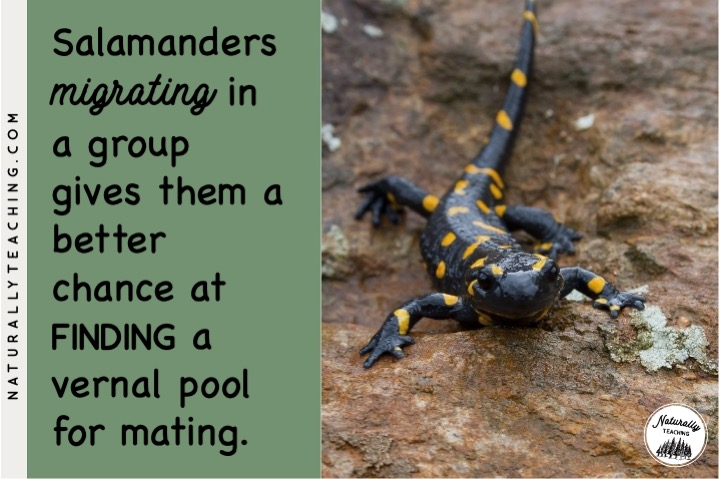
Since salamanders are all looking for the same type of pool, they end up migrating together in a group called a herd which helps them find a pool easier. Some salamanders return to the vernal pool where they were born, so if there’s a group that has some salamanders that have a strong pull toward their birth place, that can help steer the group to success.
Another benefit to salamanders migrating together is that they know there will be other salamanders to mate with. Male spotted salamanders wave their tails for the females once they’re in the water, but as mentioned earlier, they don’t have vocal sacs so they can’t call them to the vernal pool. If they all migrate together, the salamanders have a better chance of finding another salamander to lay eggs with.
Frogs are noisy amphibians, using their loud calls to attract mates during mating season. Male frogs have vocal sacs that they use to help them create those loud sounds to call females to the vernal pool or pond that they’re waiting in. But, why would a male frog want to join a group of male frogs all competing for the same females?
The biggest benefit to joining a group of male frogs, called a chorus, is that more voices equals a louder sound. This gives all of the males a chance to attract females since their calls can be heard farther away from the pond if they all sing together. If there’s only one male calling in a vernal pool or pond, he’s a lot less likely to attract females because they can hear there’s only one option and he may not be what they’re looking for.
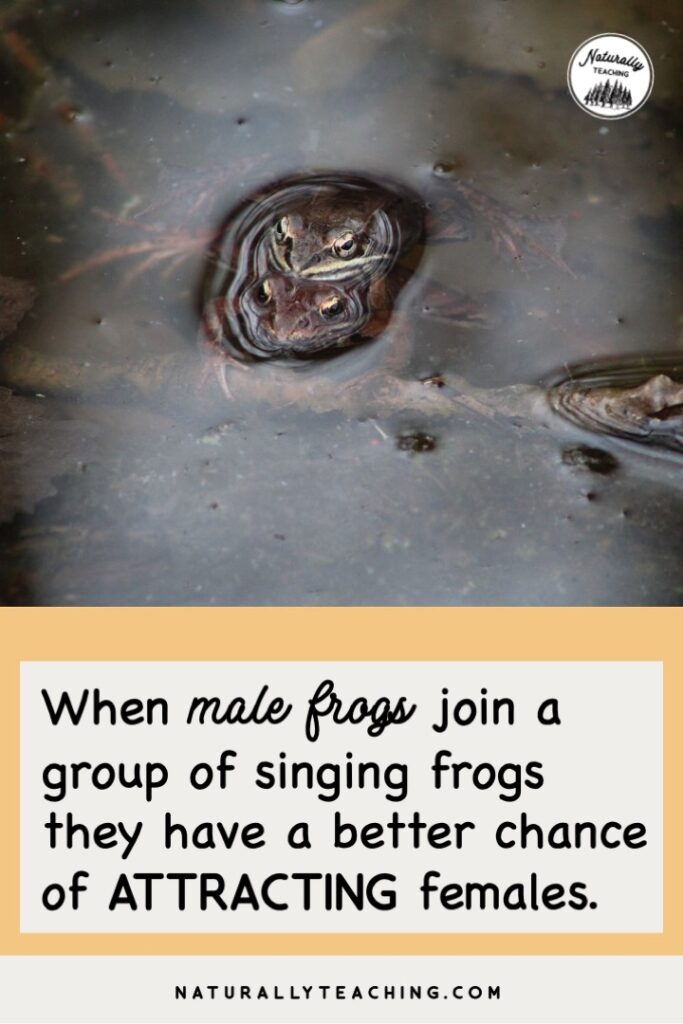
Many frogs use vernal pools to lay eggs, and unfortunately, not all vernal pools return each year. These special little wetlands are only around in the spring which means they don’t have fish or turtles, making them the perfect nursery for frog eggs and tadpoles.
But, sometimes they’ll be there for three years and then they won’t be there for a year. So the second benefit of male frogs joining a chorus is that they can help direct the females to them in case the vernal pool they used the year before is gone.
Toads are also noisy amphibians and are considered by scientists to be a sub-group of frogs. Like frogs, male toads have vocal sacs and they sing to attract females to the body of water they’re waiting in. They get all of the same benefits as frogs do for joining a group during mating season.
An added benefit for toads to gather in a group, also called a knot, is that they can keep each other safe from predators. When male toads call to females, they’re putting themselves in a very vulnerable position. They sit up high on sticks or cattails and their calls create ripples in the water that make them easy to find.

By calling in groups, toads can warn each other of predators by going silent and then other toads in the group know there’s something wrong. This is called mutual vigilance. When there are more toads in a group, there are more eyes watching for predators, and then they all can react quicker to avoid the threat.
(Frogs and toads together benefit from mutual vigilance when they sing in a chorus or a knot; more eyes equals more awareness and safety.)
Many amphibians lay their eggs in groups and this can be for multiple reasons. One reason that amphibians lay their eggs in groups is that many amphibians fertilize their eggs with external fertilization. For frogs and toads, the male grabs the female’s back, and as she lays her eggs, the male fertilizes them in the water. If the female frog or toad laid just one at a time, the male would have a harder time keeping up and making sure each egg got fertilized. By laying a lot at once, both males and females can make sure their eggs are successful.
For salamanders, the females lay their eggs in a group called a mass to help protect them from predators. Spotted salamanders in particular cover their eggs with an extra layer of jelly to help protect the eggs from being eaten by predators. If the female salamanders laid each egg by itself, the extra layer wouldn’t be thick enough to protect the babies. The grouping of eggs also makes sure that the baby salamanders have more consistent temperatures for growing.
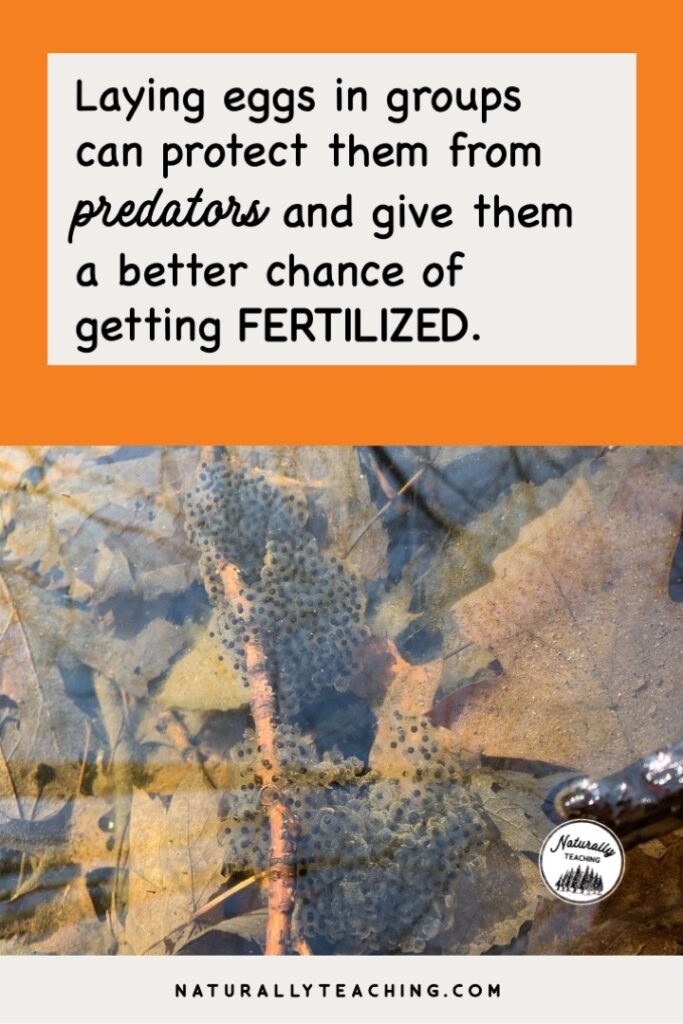
For American toads, females can lay between 2,000 and 20,000 eggs at one time! This crazy number of eggs is because toad eggs and tadpoles are a much loved food source for many animals that use vernal pools and ponds. So by laying a lot of eggs together, there is a better chance that some of the eggs and tadpoles will survive to the end of their metamorphosis and will keep their species going.
Once the eggs of frogs and toads hatch, they emerge as tadpoles and are a good source of food for bigger animals. But because many of them hatch from a group of eggs, they are surrounded by a bunch of other tadpoles giving them a better chance at growing up.
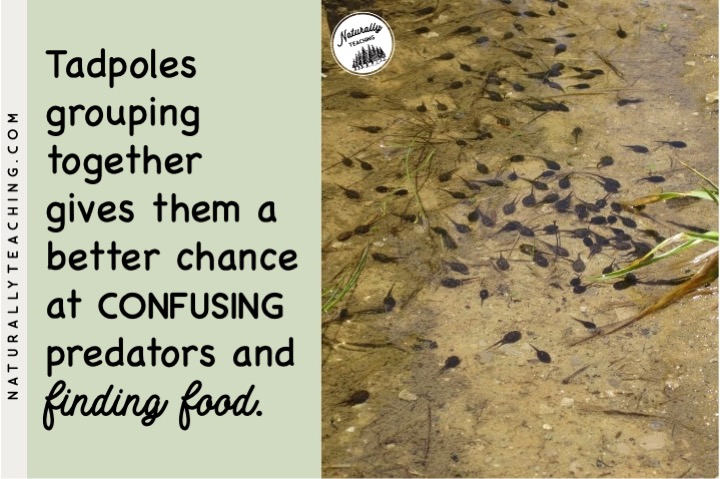
A group of tadpoles is called a school, and much like a school of fish, they swim together to stay safe from predators. The way that a school of tadpoles stays safe is called the confusion effect. When there are a lot of one kind of animal grouped together, it can be hard for a predator to see an individual to chase after. This leads the predator to be confused and helps keep more of the tadpoles from being eaten.
Another possible way that tadpoles benefit from grouping together is that it could help them find food easier. If there are more eyes looking for food, there’s a better chance they’ll find what they need to survive.
Teaching about frogs and toads together in your elementary classroom can really catch your students’ attention. Being able to answer the question, “why do amphibians form groups for survival?” can take some real critical thinking skills on the part of your learners, but this article holds just what they need to develop an informed answer. Plus, it can help you reach your curricular goals about animal behavior! I hope reading this article got you inspired to teach about amphibian groups in your classroom this spring!
And if you read this article and haven’t gotten the accompanying resource, Frog Life Cycle and Grouping Mini Unit for 3rd Grade, you can snag it here! It’s got made-for-you ELA and science activities aligned with Common Core State Standards and Next Generation Science Standards that pair with any picture book about frog life cycles. Activities included are:
Bibliography
(n.d.) Spotted Salamanders and Their Egg Masses. Retrieved from https://www.vernalpools.me/wp-content/uploads/2020/10/Spotted-Salamanders-and-their-Egg-Masses.pdf
Do you have any amazing experiences teaching about frogs and toads together in your classroom? Describe them in the comments section to inspire a fellow elementary teacher to take action!
Looking for more animal adaptation information? Check out “Over and Under the Snow by Kate Messner: Teaching Animal Adaptations” and “What Butterfly Looks Like A Monarch and 4 Other Butterfly Survival Strategies”
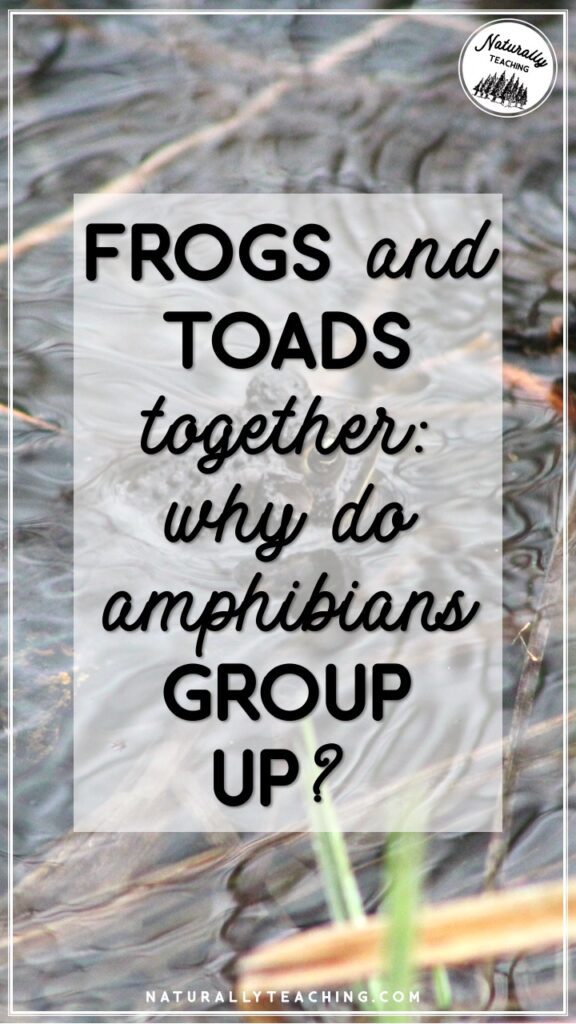
0